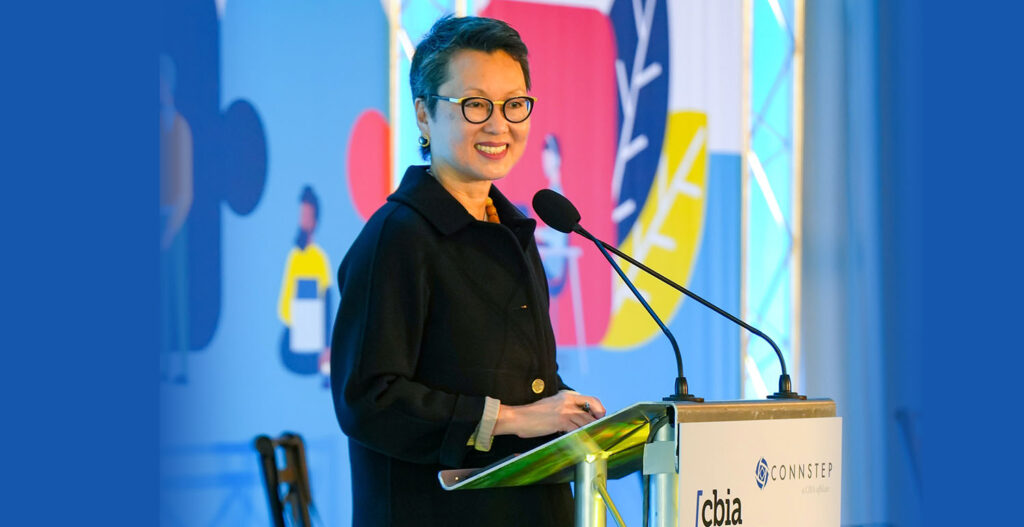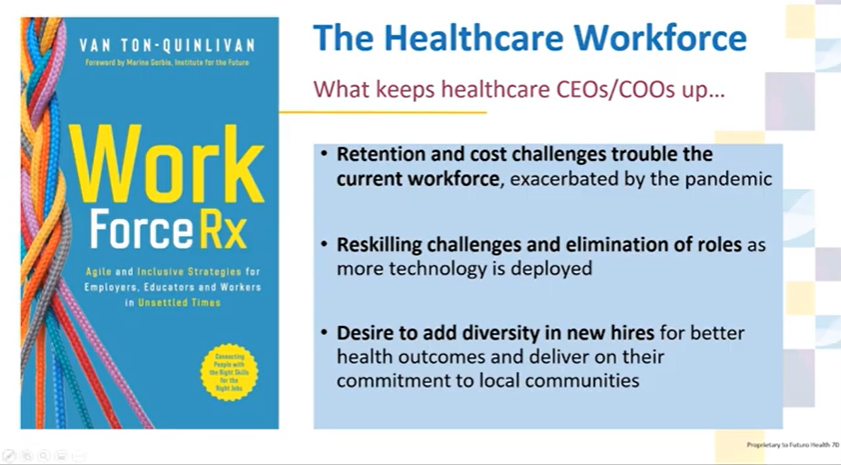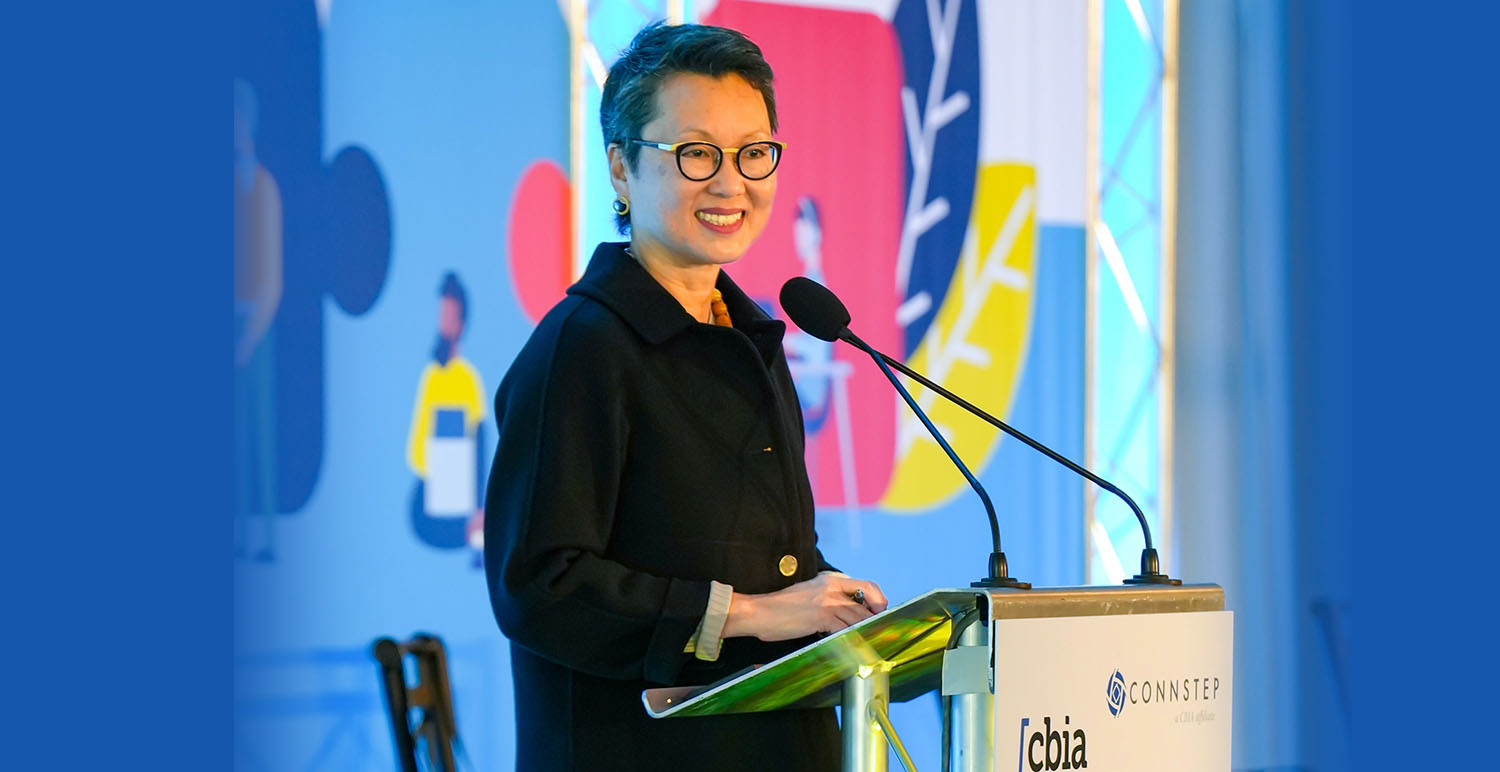
Through our Futuro Health Speakers Bureau , I am frequently invited by employer groups, national organizations, and education- and workforce-based organizations from across the country to speak. At these conferences, symposiums, forums, and other events, I highlight best practices from my book Workforce Rx: Agile and Inclusive Strategies for Employers, Educators and Workers in Unsettled Times to inspire action. (Note: Proceeds go to benefit Futuro Health’s nonprofit mission). Although states have their differences, what they have in common is a shared pain around their shortage of healthcare workers. While the need for physicians and nurses has been widely publicized, the shortage of allied health workers too often goes overlooked.
According to new data, the allied health worker shortage has put employers in a highly precarious situation, with 85% of healthcare facilities facing unprecedented needs for allied health professionals. In California alone, the deficit of allied health workers is expected to increase to 500,000 by 2024. The demand for these essential workers, including medical assistants, pharmacy technicians, health IT specialists, EMTs, phlebotomists, peer support specialists, community health workers and more, has reached critical levels, adding to an already strained healthcare delivery system in the U.S.
My book drew from my years of experience in the private, public, and now nonprofit sector refining best practices in workforce development. Doing speeches to Wyoming, DC, NY, Connecticut, Colorado and California audiences helped me understand which workforce challenge, which stories, which solutions best resonates. Let me share with you what themes states have in common.
Aleki’s Story, A Fishing Tale
Recently I keynoted the Connecticut Workforce Summit, hosted by the state’s largest business organization, CBIA, and by Social Venture Partners. Like other states, Connecticut is facing significant worker shortages in many sectors, from manufacturing to healthcare. Mark Argosh, chair of Connecticut Governor Workforce Council (and WorkforceRx podcast guest speaker), estimates 109,000 job vacancies, which is more than the number of those unemployed in the state.
One-third of high school graduates in Connecticut do not go on to any form of higher education. Connecticut fortunately does prepare youths while they are still in high school for careers by collaborating with the state’s school systems to develop career pathways. Post high school, many are stuck in low-wage jobs and are prime candidates for upskilling. Others may have the necessary requisites but encounter problems navigating the search and hiring process. That population needs a different solution and employing industry sector strategies has enabled the state to do deeper work. On the sidelines, a large number of disconnected youths – estimated at 40,000 – are neither working nor attending school and need to be reengaged in order to supply the needed workforce.
Speaking to the Connecticut audience of mostly 500 business leaders and employers, I shared the story of Aleki from my book chapter entitled: Leveling the Slope of Unconscious Bias. During an earlier time in my career working in the energy sector, I launched and led the Pacific Gas and Electric PowerPathway(tm) workforce development program, where I met Aleki, an inspiring 19-year-old who was seemingly a good fit for an open position in our organization. Following the standard drug screen, background check and completion of a 3-month pre-hire training, we were perplexed as to why Aleki had fallen off the short list of candidates.
Upon making inquiries, we learned that Aleki didn’t pass his background check due to, of all things, an unpaid fishing fine he received at the age of 15 for catching a fish that was too small by local regulations. Aleki was unaware that his unpaid fine escalated up through the court system, leading to him being charged with a nonviolent felony. Fortunately, our community partner helped Aleki get his record expunged, and he got the job.
Aleki’s story serves as an example of why workforce development is a team sport between employers, education providers, and the workforce- or community-organizations, with each stakeholder doing what they do best, to enable the Alekis to enter the talent pipeline. The collaborative efforts in Connecticut – including career pathways, sector strategies, and a collaborative approach to workforce development – combine to put Connecticut in the right direction. Connecticut received in 2022 the largest federal Good Jobs Challenge grant award (nearly $25M) for its momentum.
The Robot Zombie Apocalypse and other Misperceptions
There have been many misperceptions related to workforce development, artificial intelligence (AI) and robotic process automation. For years I’ve been hearing about the coming of the robot zombie apocalypse, the speculative fear that AI and automation will replace humans in the future of work.
This past summer I was honored to speak on a panel about Automation and the U.S. Workforce, hosted by The National Academies, a private, nonprofit institution that provides expert advice on some of the most pressing challenges facing the nation and world, shaping sound policies, informing public opinion, and advancing the pursuit of science, engineering, and medicine. Carnegie Mellon University Dr. Tom Mitchell of the National Academies invited me to address its leadership body tasked with refreshing a report to Congress on the impact of AI.
I reflected on the views of leading experts from both private and public sectors, including Jamie Merisotis, CEO of The Lumina Foundation, and author of his own book: Human Work in the Age of Machines. Experts like Jamie agree that one of the things that differentiate humans from machines in the workplace is that for us as humans, work matters. AI lacks the softer skills to work in jobs that require critical thinking and creative approaches. Like Dr. Mitchell who espouses that AI will augment the workers (hear him speak on my podcast interview of him here), Jamie believes AI and automation do not pose a threat to the workforce as much as it will open opportunities for a more collaborative relationship between employers and technology.
To prevent the worker from being left behind with advances in technology, however, regular skills upgrades will be required. What states have in common is the challenge to bring down structural silos that hinder employers and education from working together more symbiotically. The chapter in my book entitled Making the Fire Hose and the Garden Hose Work Together advances the premise that education and employment can no longer operate independent of each other’s respective priorities. Employers need to form consortia to aggregate jobs across divisions, suppliers, adjacent industries, and competitors – and better match the economics of higher education to engage in creating up-to-date curriculum needed especially by working learners to keep pace with the workplace changes.
Uniting for Solutions
Perhaps one of the most impactful examples of collaboration I observed while on speaking across state lines comes from my participation earlier this year in the kickoff meeting of the National Governors Association’s (NGA) Healthcare Workforce Collaborative. The NGA is a bipartisan organization comprised of the nation’s governors, with a mission to share best practices and speak with a collective voice on issues of concern impacting all 50 states.
This kickoff NGA meeting marked the introduction of a six-month multi-state program collaboration aimed at addressing the healthcare workforce shortages in 14 states. By learning directly from other states and national experts, the participating states understood innovative policies, programs, and practices to create a positive environment for an enduring healthcare workforce.
In my keynote, I offered up solutions drawn from in my book to address what keeps healthcare CEOs and COOs up at night, touching on such issues as retention, cost, and reskilling challenges, as well as the desire to add diversity in new hires.

The lack of healthcare workers has become so prevalent across the country that more than 20 governors this year directly addressed the situation in their state of the state speeches, proposing a range of policy fixes and funding initiatives, including California Gov. Gavin Newsom, who recently announced a new plan to invest $4.7 billion to overhaul California’s mental health system by adding 40,000 new skilled workers in mental health fields.
This level of cooperation and rallying among states to find common ground solutions to the healthcare workforce shortage underscores my earlier point that the shortage has indeed become a national crisis, impacting those in every state.
During any crisis, it is human instinct to want to play defense. Instead, applying best practices in workforce development – as outlined in WorkforceRx – puts in place proactive tactics that equip an organization with the right skills at the right time. I am encouraged by the openness of the many groups I speak who are recognizing that this is the right time to reconceptualize staffing shortages as an opportunity among industry, education, government and regional organizations and providers to work together on a solution. Workforce development, after all, is a team, not individual, sport.
Futuro Health CEO Van Ton-Quinlivan is a nationally recognized expert in workforce development. Her distinguished career spans the private, public, and nonprofit sectors. She is a White House Champion of Change and California Steward Leader, and formerly served as Executive Vice Chancellor of the California Community Colleges.

